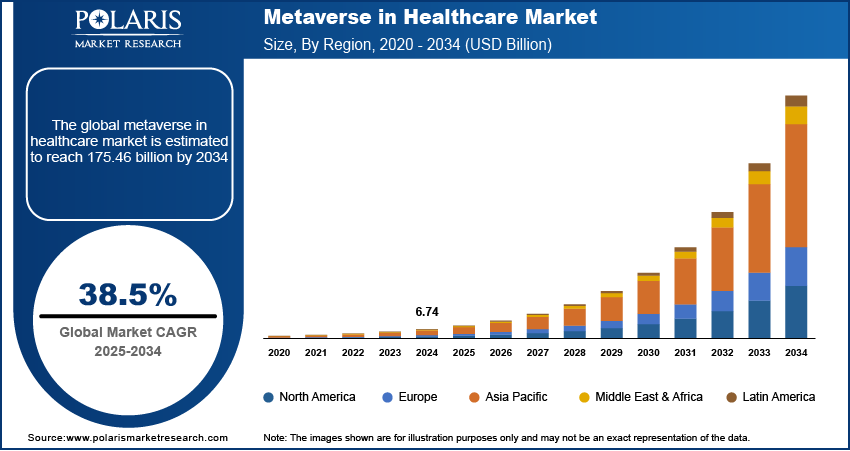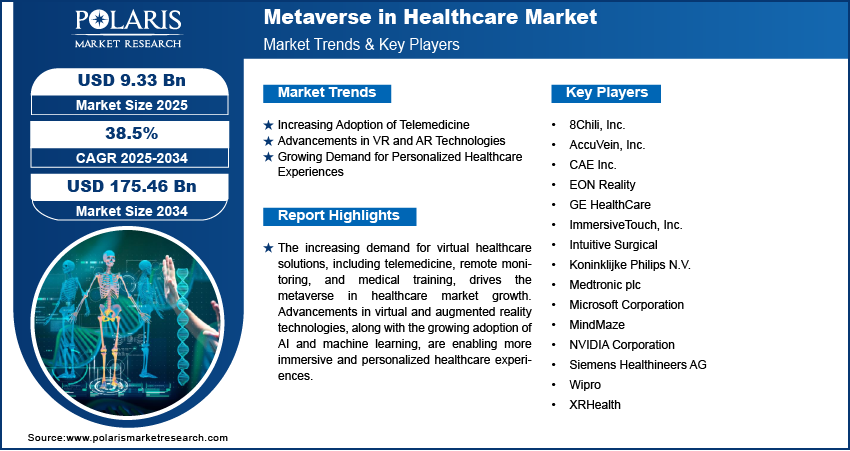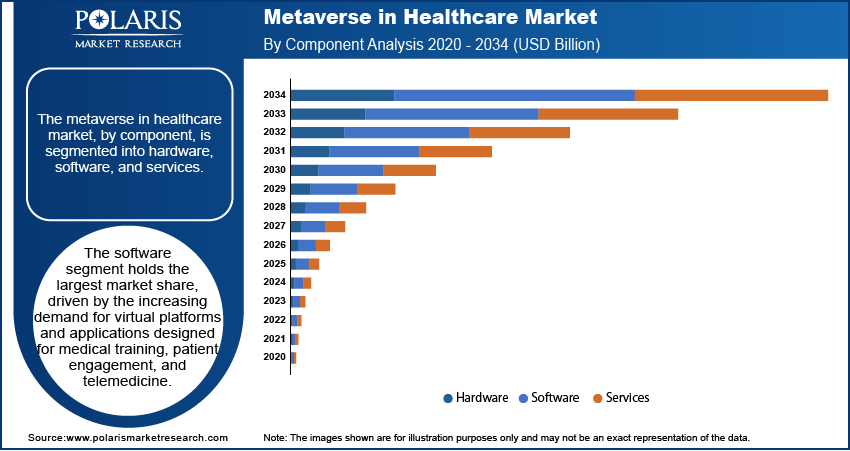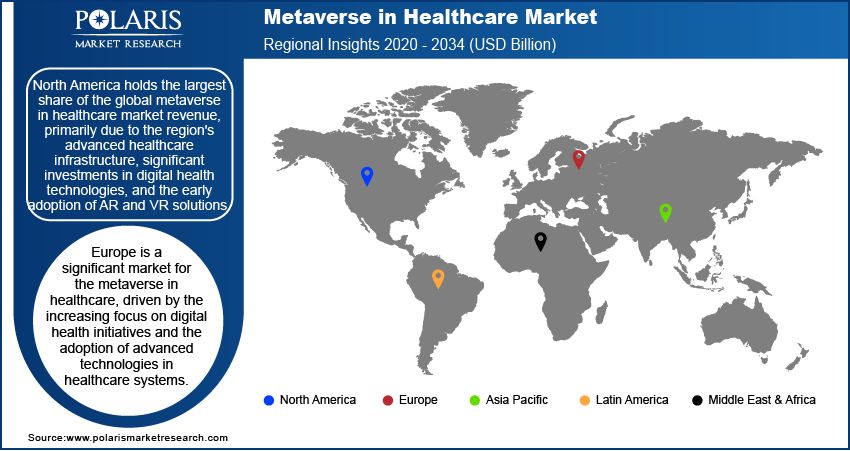
Metaverse in Healthcare Market Share, Size, Trends, Industry Analysis Report, By Component (Hardware, Software, Services); By Technology; By End User; By Region; Segment Forecast, 2024- 2032
- Published Date:Jan-2024
- Pages: 118
- Format: PDF
- Report ID: PM3878
- Base Year: 2023
- Historical Data: 2019-2022
Report Outlook
The global metaverse in healthcare market was valued at USD 9.82 billion in 2023 and is expected to grow at a CAGR of 52.40% during the forecast period.
The Internet of Things (IoT) has paved the way for remote patient monitoring, a vital component of modern healthcare. The metaverse seamlessly integrates with IoT devices, allowing real-time data collection and monitoring within virtual environments. Healthcare providers can access a wealth of patient data, enabling proactive care and timely interventions.

To Understand More About this Research: Request a Free Sample Report
Clinical research and trials are essential for advancing medical science, but they can be resource-intensive and time-consuming. The metaverse revolutionizes this process by offering virtual clinical research platforms. Researchers can create virtual patient populations, simulate trial scenarios, and collect data from participants within the metaverse. This approach accelerates drug development and medical research.
In addition, several alliances are being formed to develop innovation solutions.
- For instance, in January 2022, The Metaverse Doctors Alliance (MDA) was launched in South Korea with the aim to offer virtual healthcare globally.
Mental health has gained recognition as a critical component of overall well-being. The metaverse provides new avenues for mental health treatment and therapy. Virtual therapy sessions and exposure therapy for phobias and anxiety disorders offer patients a safe and controlled environment to address their mental health concerns.

The advent of telemedicine and virtual consultations has been accelerated by the COVID-19 pandemic. Healthcare providers are increasingly adopting virtual platforms to interact with patients, and the metaverse provides a compelling extension to this trend. Virtual consultations within immersive digital environments offer healthcare providers a unique opportunity to connect with patients remotely while preserving a sense of presence. This drive for virtual healthcare services is a significant driver for the metaverse in healthcare.
Growth Drivers
Increased demand for telemedicine and virtual consultations is projected to spur the market demand
The metaverse continues to evolve as a premier platform for advanced medical training and surgical simulations. This will empower healthcare professionals to develop unparalleled skills and expertise. The metaverse delivers immersive medical training environments where medical students and professionals can practice surgeries, patient care, and complex procedures within a virtual realm. These simulations offer a risk-free space for learning and skill refinement, enhancing the competency of healthcare professionals.
The metaverse responds to the growing demand for telemedicine and virtual consultations. Telehealth services have gained prominence, driven by factors such as the COVID-19 pandemic and the need for remote healthcare access. The metaverse enhances these services by providing immersive, interactive environments for doctors and patients to connect. It enables healthcare providers to offer consultations with a sense of presence, transcending the limitations of traditional video calls.
The metaverse can bridge gaps in healthcare access, particularly in underserved or remote areas. Patients in regions with limited healthcare infrastructure can benefit from virtual consultations and access to medical expertise within the metaverse, contributing to global health equity.
Report Segmentation
The market is primarily segmented based on component, technology, end user, and region.
|
By Component |
By Technology |
By End User |
By Region |
|
|
|
|
To Understand the Scope of this Report: Speak to Analyst
By Component Analysis
Software segment expected to experience significant growth during the forecast period
The software segment is expected to experience significant growth during the forecast period. As telemedicine gains prominence, there is a growing need for software that facilitates seamless virtual consultations within the metaverse. This includes platforms that offer secure video conferencing, real-time data sharing, and interactive features for doctors and patients to engage effectively. Healthcare institutions are seeking sophisticated software solutions that create immersive and realistic training environments within the metaverse. These platforms must support lifelike simulations, 3D anatomical models, and interactive scenarios for medical education. Demand is increasing for software that can seamlessly integrate with IoT devices to enable remote patient monitoring within the metaverse. Such software should provide real-time data analysis, alerts, and user-friendly interfaces for both healthcare providers and patients.
By Technology Analysis
Augmented/virtual reality accounted for a significant market share in 2022
The augmented/virtual reality segment accounted for a significant share in 2022. AR/VR is reshaping medical training by providing lifelike simulations. Healthcare professionals and students practice intricate surgical procedures, patient care, and medical scenarios within virtual environments, honing their expertise in a risk-free setting. Patients and healthcare providers can engage in virtual clinical consultations through AR/VR, enabling remote diagnostics, monitoring, and treatment planning in an engaging and interactive visual realm. This breakthrough enhances healthcare accessibility, particularly for remote or underserved populations. VR is being harnessed for pain management and therapeutic interventions. Patients can immerse themselves in soothing, therapeutic settings during treatments, effectively reducing anxiety and discomfort. This application is particularly beneficial in pain management and mental health therapies.
By End User Analysis
Healthcare Providers segment held the significant market revenue share in 2022
The healthcare providers segment accounted for a significant share in 2022. Healthcare providers are increasingly adopting the metaverse to revolutionize their services and elevate patient care. Healthcare institutions are now offering virtual consultations via the metaverse, providing patients with the ability to connect with physicians, specialists, and therapists remotely. This not only enhances healthcare accessibility but also minimizes the necessity for physical visits, especially for routine appointments and follow-ups. Some healthcare providers are establishing centralized virtual telemedicine hubs within the metaverse. Metaverse environments are being harnessed for rehabilitation and physical therapy purposes. Patients can partake in virtual exercises and therapy sessions guided by healthcare professionals, making the recovery process more engaging and accessible.

Regional Insights
Asia-Pacific is expected to experience significant growth during the forecast period
Asia-Pacific is expected to experience significant growth during the forecast period on account of the growing elderly population and improvements in healthcare infrastructure. The Asia-Pacific area is experiencing a surge in digital health innovations within the metaverse. This includes virtual healthcare consultations, telemedicine services, and the monitoring of health metrics in virtual settings. Factors such as a large population, increasing smartphone and internet accessibility, and a rising middle class with disposable income are propelling the adoption of metaverse-based healthcare solutions. Governments in the Asia-Pacific region are closely monitoring the impact of the metaverse on healthcare. Regulatory frameworks and guidelines are being developed to safeguard patient data privacy, uphold medical ethics, and ensure the safety of virtual healthcare services.
North America emerged as the largest region in 2022. The United States has seen a substantial uptick in the utilization of virtual platforms within the metaverse for healthcare consultations. Factors such as a tech-savvy population, a culture of healthcare innovation, and a focus on patient-centric care are propelling the metaverse in healthcare market expansion. Patients now have the convenience of accessing medical advice and services while connecting with healthcare professionals through virtual channels. The metaverse has become a hub for patient engagement and support groups in the U.S. Patients dealing with chronic conditions, mental health challenges, or rare diseases can connect with peers in virtual environments to share experiences and find emotional support.

Key Market Players & Competitive Insights
The metaverse in healthcare industry is characterized by its fragmented structure, poised for heightened competition due to the numerous players in the industry. Leading participants in this market continually bring forward innovative solutions to bolster their presence. These firms place significant importance on forging partnerships, enhancing their product portfolios, and actively collaborating to gain a competitive advantage over their counterparts and secure a significant market presence.
Some of the major players operating in the global market include:
- CAE Inc.
- CMR Surgical
- GE HealthCare
- ImmersiveTouch, Inc
- Intuitive Surgical
- Koninklijke Philips N.V.
- Medtronic plc
- Microsoft
- MindMaze
- NVIDIA Corporation
- Oculus
- Siemens Healthineers AG
- Wipro
- XRHealth
Recent Developments
- In February 2023, Indegene unveiled metaverse functionalities to assist life sciences enterprises in numerous scenarios, encompassing interactions with healthcare providers (HCPs), HCP education, and patient education. Leveraging Indegene's extensive domain knowledge, life sciences organizations will find a solid footing to navigate the intricacies of this emerging technology and the adaptability to craft bespoke virtual realms.
- In March 2022, GOQii joined forces with Animoca Brands and its network of affiliated firms to create a range of solutions that harness blockchain tokens and gamification in preventive healthcare. At the heart of GOQii's metaverse ecosystem, lies an exclusive virtual token system known as the "Token." Users will receive these virtual tokens, which serve as the essential component of the GOQii metaverse ecosystem, encouraging healthy practices and engaging fitness activities through gamification.
Metaverse in Healthcare Market Report Scope
|
Report Attributes |
Details |
|
Market size value in 2024 |
USD 9.82 billion |
|
Revenue forecast in 2032 |
USD 434.54 billion |
|
CAGR |
52.40% from 2024 – 2032 |
|
Base year |
2023 |
|
Historical data |
2019-2022 |
|
Forecast period |
2024 – 2032 |
|
Quantitative units |
Revenue in USD billion and CAGR from 2024 to 2032 |
|
Segments covered |
By Component, By Technology, By End User, By Region |
|
Regional scope |
North America, Europe, Asia Pacific, Latin America; Middle East & Africa |
|
Customization |
Report customization as per your requirements with respect to countries, region and segmentation. |
